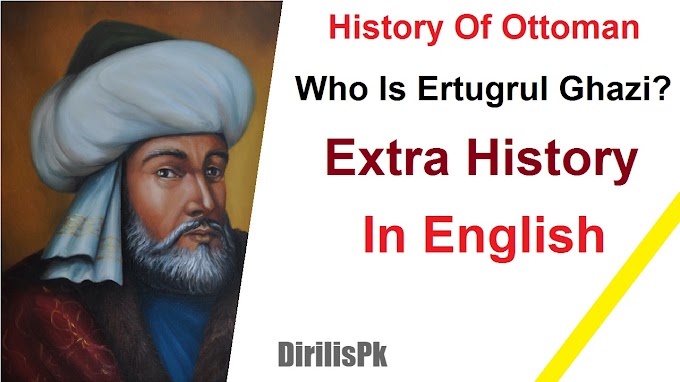The Early Ottoman Army || History Of Ottoman Empire
Hi Guys In This Article I Well Show With You History Early Ottoman Army , History Of Ottoman EmpireThe Ottoman Empire was around for a really long time. And because of that they’re military looked really different at the start than it did at their end. Today I'm going to talk about the beginnings of the Ottoman military institution from the 14th and 15th centuries.
The Ottoman army, when the Empire was founded in 1299 by Osman I, was made up of nomadic Turk men that fought on horse back with bows and spears. The fact that these early troops were nomadic meant that they were incredibly mobile… excelling at hit and runs, ambushes, feigned retreats, and surprise attacks: all of that fast-paced warfare. They earned their money by raiding conquered territory. And they tended to be loyal to their commanders and not the Ottoman Empire itself. These Turk men were pretty powerful, but just like a lot of other nomadic armies throughout history, they were really unorganized and not really disciplined. They kind of sucked at siege warfare, and,in turn, taking large cities. Osman I, appeared to be okay with this as no reform efforts were made during his reign. After all, they were a new empire, they couldn’t get too greedy yet.
The Ottoman Empire ArmyOrhan, the second sultan of the Ottoman Empire,replaced the nomadic army with mercenary soldiers, dividing them into two units: the infantry was known as the Yaya and the cavalry was called the musellum. The yaya was not a standing infantry, working on farms during peacetime, only being paid salaries when they were fighting. Majority of the Yaya and the Musellum was made up of Christian men who were not required to convert to Islam as long as they obeyed commanders. The mercenaries became the bulk of the Ottoman army and as for the Turk men nomads who served from the start. They were reduced to shock troops known asakinci, still paid only through the spoils of war. During this early period in Ottoman history, newly conquered lands were immediately divided among st the soldiers, becoming their own personal domains.
History Of Ottoman Empire
 |
| The Early Ottoman Army |
Eventually, two problems are
1) : the Turk men settled in those domains and no longer carried out the military duties for the Empire. 2): The salaries given to the yaya and musellem were becoming too heavy of a burden on the Ottoman treasury. The solution to both of these: The timar system,established in 1359, under Murad I, the third Ottoman sultan. With this system in place, conquered areas remained the property of the empire, but the tax revenue from the land was divided among soldiers. The area that a soldier could gain tax revenue from, similar to a feudal fief in Europe, was called a timar. Soldiers could either lose or gain timar based on performance. If you stopped serving the army, it was takena way. You continue to serve and conquer more territory.
History Of Ottoman Empire In English
Well, here’s another timar. This incentive and punishment setup reached peak efficiency in the 1450 s, and was a huge reason behind the successes of the Ottoman military. As the Ottoman Empire continued to grow, Murad I built up personal power through the establishment of a military slave force known as the Kapikulu in the mid 1300 s. The Kapikulu was based on a special tax, which was introduced to take one out of every five slaves for the Ottoman’s central treasury. The Kapikulu had an infantry branch, known as the Janissaries, and a cavalry branch, called the Six Divisions of Cavalry. Less than forty years later, due to the pressure of Turkish nobles, in an attempt to curb the sultan of his power the Kapikulu was abolished. The nobles justified their opposition to the kapikulu based on the Islamic tradition that Muslims could not be kept in slavery-even though the Ottomans were doing that for over Anyway, Murad I still wanted household troops,especially an infantry, and so he reinstated the kapikulu under the devshirme system. The devshirme was a forced tribute of selected children from their Christian families. These children, once trained, would serve in the Janissary corps, or any other corps under the kapikulu.
 |
| The Early Ottoman Army |
The Janissaries surpassed all of the previous troops in terms of military ability, and, well, it’s because the devshirme was a really efficient system for the Ottomans. They had children trained at a young age, increasing their ability and instilling loyalty to the sultan. Problem was, as an elite unit, the Janissaries were pretty expensive, low in number, but necessary to have. The Ottomans needed soldiers who were expendable and easy to replace. This is where the Azabs came in. The Azabs were mercenaries, hailing from west Anatolia, looking for money through war. They were light infantrymen, who provided their own armor and weapons. Fighting on the front lines and carrying out a lot of dangerous duties. Like I said, expendable. That means high casualty rates. and high rewards, so finding people who wanted to fight in the name of the Ottoman Empire was not hard at all The Ottoman Empire was the first of what’s called the gunpowder empires and for good reason too. Yes they started using guns in the late thirteenth century, but what really earned them this title was the fact that during this time period They utilized canons like no other. With their gunpowder artillery, the Empire was able to bring down the Theodosian walls that surrounded Constantinople for almost a thousand years. And by this time, the use of firearms was regularized-especially among the Janissaries. Though many stuck to their bows merely becausetheir accuracy rate was a lot higher than that of early firearms. But really until the seventeenth century,the Ottomans were at the forefront of military technology. So what changed? Well, that’s a question I'll be answering in next article so, stay tuned!
Last Words
Thank you so much to read this article, if you like this then please tell me your views into comments section, also like and share this article with your family & friends. Thanks





0 Comments